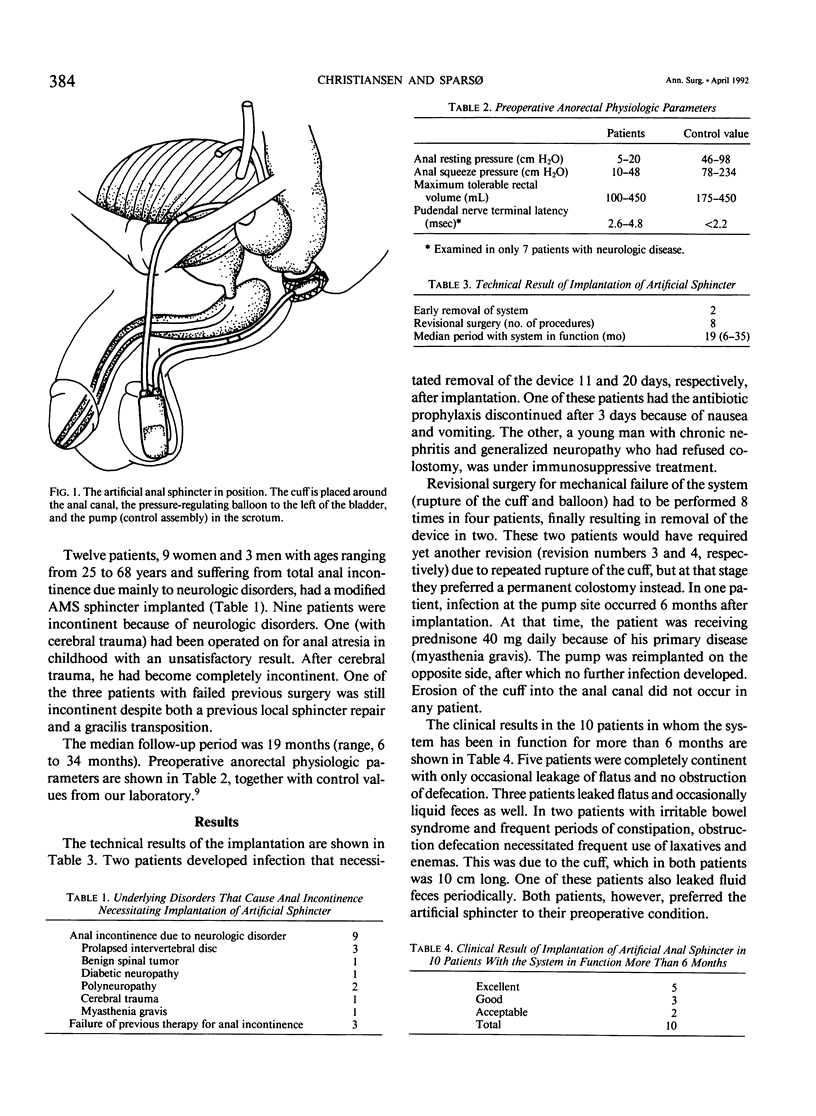Abstract
Twelve patients with anal incontinence due to neurologic disease or failure of previous incontinence surgery underwent implantation of an artificial anal sphincter. The system used was a modification of the AMS 800 artificial urinary sphincter. In two patients, infection necessitated removal of the system, and in four patients, eight revisional procedures had to be performed because of mechanical failure. After various modifications of the system, especially reinforcement of the closing mechanism of the cuff, only one case of mechanical failure has occurred. Erosion through the anal canal did not occur. Among 10 patients with the system in function for more than 6 months, the result was considered excellent in 5, with only occasional leakage of flatus, good in 3, who occasionally leaked liquid feces and flatus, and acceptable in 2, in whom the cuff obstructed defecation. It is concluded that implantation of an artificial anal sphincter is a valid alternative to permanant colostomy in patients with anal incontinence due to neurologic disorders and in patients in whom other types of incontinence surgery have failed.
Full text
PDF



Images in this article
Selected References
These references are in PubMed. This may not be the complete list of references from this article.
- Baeten C., Spaans F., Fluks A. An implanted neuromuscular stimulator for fecal continence following previously implanted gracilis muscle. Report of a case. Dis Colon Rectum. 1988 Feb;31(2):134–137. doi: 10.1007/BF02562646. [DOI] [PubMed] [Google Scholar]
- Christiansen J., Lorentzen M. Implantation of artificial sphincter for anal incontinence. Lancet. 1987 Aug 1;2(8553):244–245. doi: 10.1016/s0140-6736(87)90829-4. [DOI] [PubMed] [Google Scholar]
- Christiansen J., Pedersen I. K. Traumatic anal incontinence. Results of surgical repair. Dis Colon Rectum. 1987 Mar;30(3):189–191. doi: 10.1007/BF02554337. [DOI] [PubMed] [Google Scholar]
- Christiansen J., Sørensen M., Rasmussen O. O. Gracilis muscle transposition for faecal incontinence. Br J Surg. 1990 Sep;77(9):1039–1040. doi: 10.1002/bjs.1800770928. [DOI] [PubMed] [Google Scholar]
- Corman M. L. Follow-up evaluation of gracilis muscle transposition for fecal incontinence. Dis Colon Rectum. 1980 Nov-Dec;23(8):552–555. doi: 10.1007/BF02988994. [DOI] [PubMed] [Google Scholar]
- Pedersen I. K., Christiansen J. A study of the physiological variation in anal manometry. Br J Surg. 1989 Jan;76(1):69–70. doi: 10.1002/bjs.1800760121. [DOI] [PubMed] [Google Scholar]
- Wexner S. D., Marchetti F., Jagelman D. G. The role of sphincteroplasty for fecal incontinence reevaluated: a prospective physiologic and functional review. Dis Colon Rectum. 1991 Jan;34(1):22–30. doi: 10.1007/BF02050202. [DOI] [PubMed] [Google Scholar]
- Willams N. S., Hallan R. I., Koeze T. H., Pilot M. A., Watkins E. S. Construction of a neoanal sphincter by transposition of the gracilis muscle and prolonged neuromuscular stimulation for the treatment of faecal incontinence. Ann R Coll Surg Engl. 1990 Mar;72(2):108–113. [PMC free article] [PubMed] [Google Scholar]
- Womack N. R., Morrison J. F., Williams N. S. Prospective study of the effects of postanal repair in neurogenic faecal incontinence. Br J Surg. 1988 Jan;75(1):48–52. doi: 10.1002/bjs.1800750118. [DOI] [PubMed] [Google Scholar]
- Yoshioka K., Keighley M. R. Critical assessment of the quality of continence after postanal repair for faecal incontinence. Br J Surg. 1989 Oct;76(10):1054–1057. doi: 10.1002/bjs.1800761023. [DOI] [PubMed] [Google Scholar]



